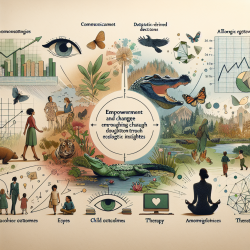Introduction
As practitioners in the field of speech-language pathology, we are often tasked with making informed decisions that have a profound impact on the children we serve. While our focus may seem worlds apart from the ecological studies of American alligators, the underlying principles of data-driven decision-making and understanding complex relationships are universal. The recent research on the ecological implications of allometric relationships in American alligators provides valuable insights that can inspire us to refine our practices and encourage further exploration.
Understanding Allometric Relationships
The study conducted by Balaguera-Reina et al. (2024) explores the static morphological allometry of American alligators across the Greater Everglades ecosystem. Allometry refers to the relationship between the size of an organism and the size of any of its parts. This research highlights the significance of understanding these relationships, as they can inform management and conservation efforts.
For practitioners, this translates to recognizing the importance of understanding the relationships between various aspects of a child's development. Just as allometric coefficients help ecologists assess the health and condition of alligator populations, understanding the intricate relationships in child development can guide us in tailoring interventions that address specific needs.
Implementing Insights into Practice
The research findings reveal that most trait-size relationships in alligators exhibit hyperallometry, meaning that certain traits grow disproportionately larger as the alligator grows. This insight can be paralleled in speech-language pathology, where certain skills or behaviors may develop at different rates. By recognizing these patterns, practitioners can better anticipate and address developmental milestones.
- Consider the impact of environment: Just as the alligator study found that habitat and sampling area influenced allometric coefficients, practitioners should consider environmental factors that may affect a child's development. Tailoring interventions to the child's specific context can lead to more effective outcomes.
- Embrace data-driven decisions: The robust dataset used in the alligator study underscores the importance of data in making informed decisions. Practitioners should leverage data collection and analysis to guide their interventions, ensuring that decisions are grounded in evidence.
- Encourage further research: The study highlights the need for ongoing research to understand the full implications of allometric relationships. Similarly, practitioners should remain curious and open to exploring new research that can enhance their understanding of child development.
Encouraging Further Exploration
The research on alligators serves as a reminder of the interconnectedness of ecosystems and the importance of a holistic approach. For speech-language pathologists, this translates to viewing the child as part of a larger system, considering factors such as family dynamics, cultural influences, and educational environments.
By fostering a culture of curiosity and continuous learning, practitioners can stay at the forefront of their field. Encouraging collaboration with researchers and engaging in professional development opportunities can lead to innovative approaches that benefit the children we serve.
Conclusion
The ecological study of American alligators offers valuable lessons for practitioners in speech-language pathology. By embracing data-driven decisions, understanding complex relationships, and encouraging further exploration, we can enhance our practice and create meaningful outcomes for children. Let this research inspire us to look beyond our immediate field and draw insights from diverse disciplines to inform our work.
To read the original research paper, please follow this link: Ecological implications of allometric relationships in American alligators (Alligator mississippiensis).










